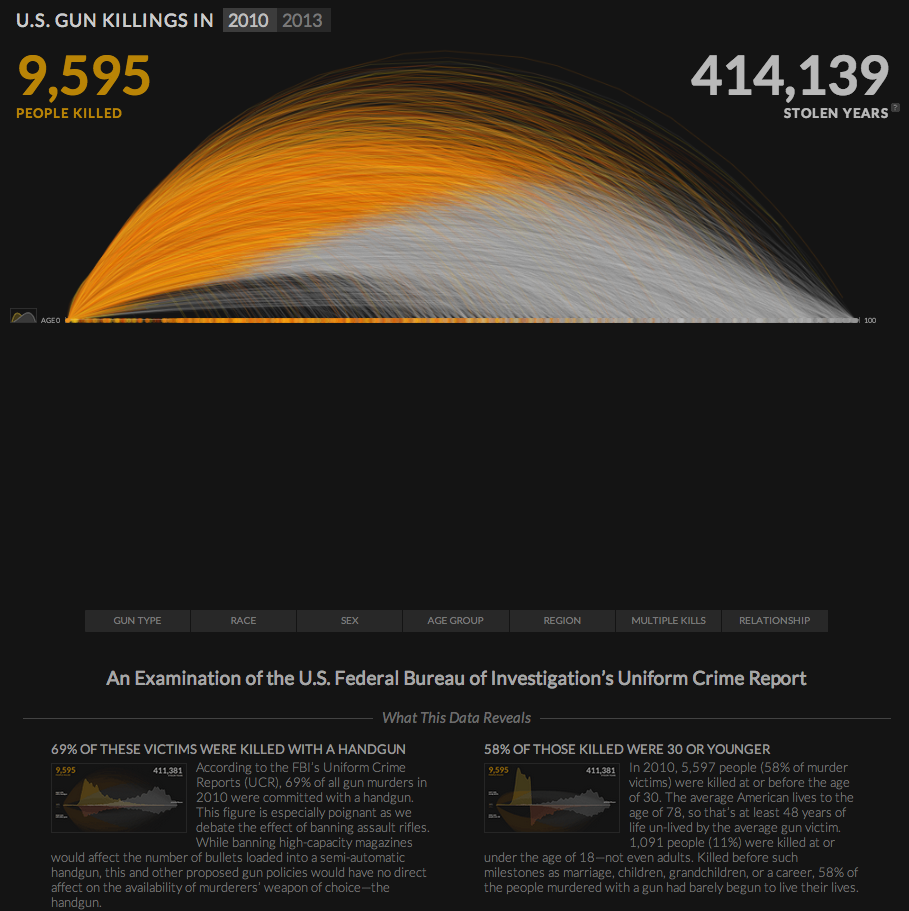Emotional Data Visualization: Periscopic's "U.S. Gun Deaths" and the Challenge of Uncertainty
The words "emotion" and "data" aren't paired very often. That's unfortunate, albeit understandable. For historical reasons, we assume that quantitative data are as objective as emotions are messy. In the simplest narratives of how the human mind operates, emotions are the source of the most prevalent cognitive biases¹, whereas the proper handling of data—gathering, experimenting, testing—is the most reliable antidote to them. There is grandeur in this view of knowledge; after all, it's the foundation of the scientific method. But there may be exceptions sometimes.
The most recent project by Periscopic²—a firm with a bold motto, "do good with data"—merges the emotional power of visualization with its ability to enhance understanding. In the process, it also prompts you to think about certain challenges that we designers will need to address sooner rather than later. Allow me to share my joy and my concerns with you.
The graphic, titled "U.S. Gun Deaths," opens with a thin orange line that arcs over an unnerving black background. A label hints that the path is the length of a person's life. His name is Alexander Lipkins.
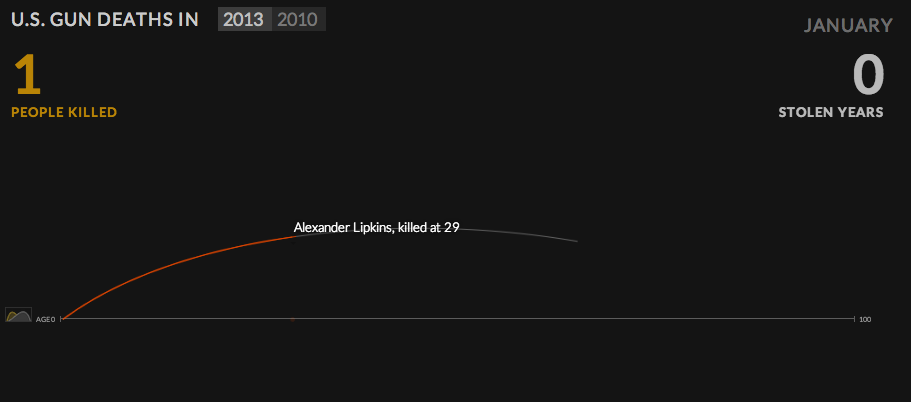
Figure 2 The interactive graphic opens with a single line, which represents the short life of Alexander Lipkins, one of the more than 2,000 people killed by gunfire in 2013.
Suddenly, when the animation reaches 29 years, it halts and a dot drops to the baseline. A life is lost. From that moment on, the line turns grey, representing the years Lipkins could have lived, were his journey not interrupted by the roar of gunfire. An instant later, the left side of the X-axis turns into a punctured hose, which sputters hundreds, thousands of lines. Invariably, orange turns to grey in all of them. Dots fall to the ground like rain.
Kim Rees, one of the designers of "U.S. Gun Deaths," says that the sum of all those grey lines depicts "the potential life that could have been spared"—more than 400,000 stolen years in 2010, and almost 90,000—so far, as the project is updated constantly—in 2013. Those figures, and the somber, sad beauty of this interactive graphic, chill you to the bone.
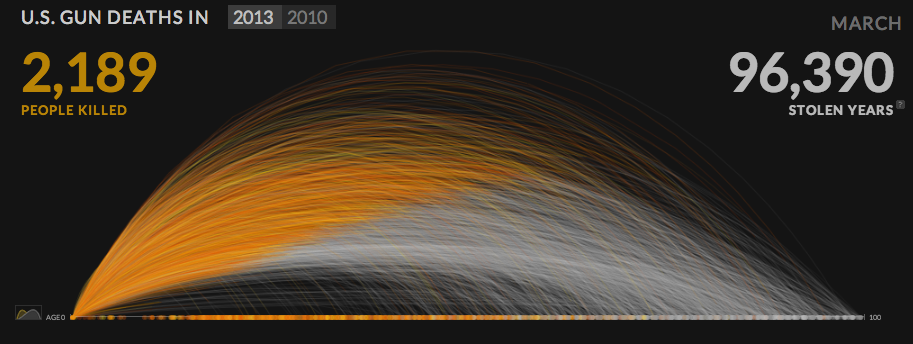
Figure 3 The animation ends, showing the total number of lives lost to gunfire in 2013. A button lets you access the numbers of 2010.
Periscopic started working on "U.S. Gun Deaths" right after the shooting at Connecticut's Sandy Hook Elementary school in which 20 children and six adults were killed. I remember Periscopic asking on Twitter if any media organization or institution was interested in publishing a visualization about gun violence. "We usually work for a client, but in this case nobody came to us, even if we offered to work for free," says Kim Rees, "so we decided to do it on our own." The second motto of Periscopic is "socially conscious information visualization." Rees clarifies it: "We want to use our skills to contribute to society, bringing attention to relevant problems."
Periscopic obtained The Uniform Crime Reports—which gathers voluntarily-reported data from police precincts—from the FBI, and also worked with information from Slate, which has published a special project about gun deaths. "We didn't want to show just the aggregates, but to display this data set in all its complexity," says Rees.
Mark Hintz, a data science specialist at Periscopic, tried to get a grasp of the information by exploring it with R and its library ggplot2³. Then, he used World Health Organization data to estimate the life expectancy of each person and the most likely cause of his or her death. In the description of the project, Periscopic explains, "We first performed an age prediction weighted according to the age distribution of U.S. deaths. Using this age, we then predicted a likely cause of death at that age. We do not adjust for life-expectancy differences between demographic groups, as we have not yet found data to that extent."
The mathematical model used to calculate those variables created a few odd outcomes, like George Whitney's case, a male who died when he was 16 years old, and whose life expectancy turned out to be…16 years.
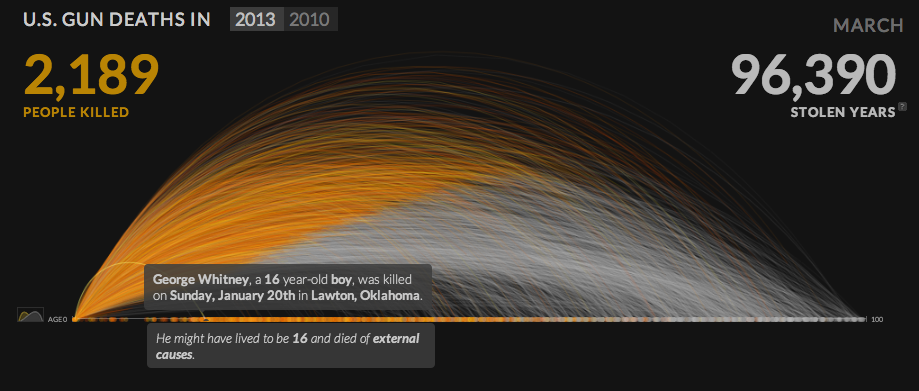
Figure 4 George Whitney's line: He was 16 years old when he died. His predicted life expectancy was also 16 years.
"We're calculating the age of death based on statistics," says Rees. "Probabilistically, some people will just die sooner than others. Only about one or two people per hundred will die in the 16-20 year age range, so while it's pretty unlikely, in a large enough sample, you're bound to see some. That may look strange in a tool like this, it may look prescient, but it's just numbers."
Probability is a strange beast, indeed. But is this project really just about numbers? Periscopic doesn't hide that it is not. Stylistic choices (color, type, animation) were made to transform the interactive not into an efficient tool for data analysis—although readers can sort and filter the lines—but into a powerful visual metaphor. The goal of "U.S. Gun Deaths" is not only to inform, but also to demand a discussion about gun control. It is a smart instrument for persuasion: "Here you have the numbers," the graphic implies. "They are worrisome. Shouldn't we talk about them?"
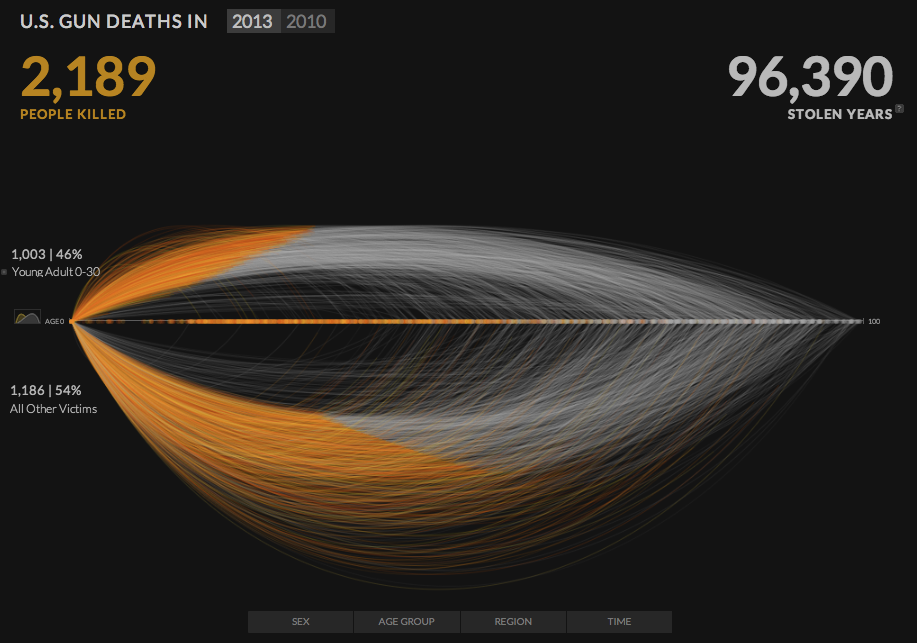
Figure 5 Periscopic's interaction lets the reader sort and filter the data in different ways.
I'll concede that the word "persuasion" sounds suspect nowadays. We tend to identify it with the shady techniques marketers develop to sell us products and services. But rational persuasion lies at the core of rhetoric, and rhetoric has a noble and long tradition in philosophy and science. It just needs to be handled with care, perhaps even more so when we use it in visual displays of information.
In a recent article about a visualization workshop sponsored by The Guardian4, the instructors described a majority of scientific output as "clarity without persuasion." They meant that researchers are trained to deal with data, and to present them in the clearest, most efficient way. But they are not good at making strong cases based on their findings. They are very careful, and for good reason: Seeing too much in your data can be dangerous.
Periscopic's project is not a scientific display, obviously. It can be better described as a visual Op-Ed, something that a knowledgeable journalist might build when trying to find the balance between what a researcher would do—get your data first; publish them—and what an opinion writer should do—promote public conversations about relevant issues. The challenges mentioned at the beginning of this article lie here: Where is the middle ground between the scientific approach and the journalistic one? To what extent is it appropriate to discuss politics around a visualization based on "just" graphically encoded data? Is it clear to a general audience that what they see is the work of professionals who actively shape data to support a cause, and not the product of automated processes?
Moreover, most modern data visualizations look very precise but aren't necessarily accurate. In Periscopic's project, the life expectancy of each person is a specific figure, not a range of ages. The visualization is very precise, but precision isn't accuracy: If I tell you that the predicted unemployment rate for 2014 is 6.965%, I am being more precise than if I say that it'll be 7%, but that doesn't mean that my prediction is accurate. I could be wrong, no matter how many decimals I add. Not to mention that maybe I should not report that figure without including some measure of error. Perhaps the right prediction is not 7%, but an interval between 6.9% and 7.1%. That would be more accurate.
Infographics and data visualizations are very good at displaying certainty, but not efficient at all at depicting its flip, dark side: doubt, variation, randomness. We have not developed enough good tools and techniques to do so yet5. I wonder if by looking undeservedly certain, some projects may even mislead readers. A data visualization may make its point with force and elegance, but it may also stash crucial information and deprive audiences of deep insights. Uncertainty is never a failure of research, but an integral part of any piece of information. I don't have good answers to any of the issues mentioned in the last few paragraphs. What I do know is that addressing them is of utmost importance to move the fields of visualization and infographics up to a higher level of ethical sophistication.
In the meantime, I guess that it would be appropriate to just enjoy the creativity and beauty of projects like this, to quietly mourn the people behind the data, and to think about what the future of gun legislation should be. Kim Rees says, "There are actions we can all do every day to change society for the better." It's impossible to disagree with such a statement. The very essence of being a citizen is speaking up with grace, honesty, and compassion when you believe that something is wrong, whether it is by means of words or visuals. In that sense, Periscopic's "U.S. Gun Deaths" is a triumph of emotion made functional.
NOTES:
(1) Wikipedia offers a comprehensive list of cognitive biases: http://en.wikipedia.org/wiki/List_of_cognitive_biases.
(2) http://www.periscopic.com. The Gun Deaths project can be found in http://guns.periscopic.com.
(3) R is an open source programming language for statistical analysis. ggplot2 is a library specially designed to create graphs. Visit http://www.r-project.org/ and http://www.ggplot2.com.
(4) Read the article here: http://adamcrymble.blogspot.com.es/2013/03/the-two-data-visualization-skills.html.
(5) Some exist for simple displays, like the box and whisker graph (http://blog.contextures.com/archives/2008/12/03/whats-a-box-and-whisker-chart/). The question is how you do that in visualizations as complex and data-rich as "U.S. Gun Deaths."
